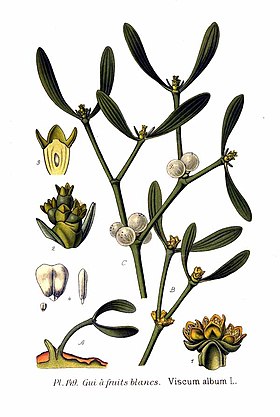Template:Species-2011-12-2
Species of the month
[edit]European Mistletoe
[edit]Some facts on this plant:
Distribution: Europe and western and southern Asia.
Leaves: Opposite, strap-shaped, 2–8 cm long.
Flowers: Yellowish-green, 2–3 mm across.
Fruit: White or yellow berry, usually with a single seed.
Medical uses: Used as a treatment for degenerative joint inflammation (osteoarthritis) and malignant tumors.
First described: By the Swedish naturalist Carolus Linnaeus in 1753.
Viscum album doesn't grow on the ground but on the branches or trunks of trees. It sends out roots that penetrate into the tree and take up nutrients. This shrub is a common holiday decoration in Europe. Sprigs of mistletoe were believed to protect the house from fire and lightning, and couples meeting under hanging mistletoe were obliged to kiss. The mistletoe was also important to the ancient Celts, who believed the plant to be an antidote for poison. Because it is a tree-parasite, the modern reputation of mistletoe has not been as favorable. However, ecological studies have shown that more new juniper trees sprout in areas with mistletoe, and that more berry-eating birds are attracted by the mistletoe's fruit, so that nearby berry-producing trees are more likely to have their seeds distributed. Currently at least six subspecies are recognized. They differ in fruit colour, leaf shape and size, and most obviously in the host trees utilised.
(Archived from Template:Species of the week)

